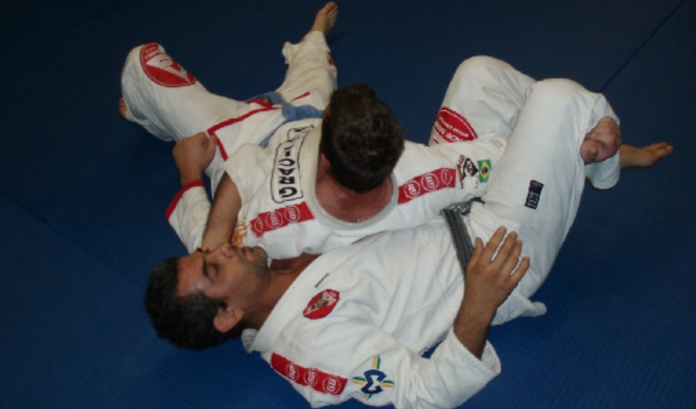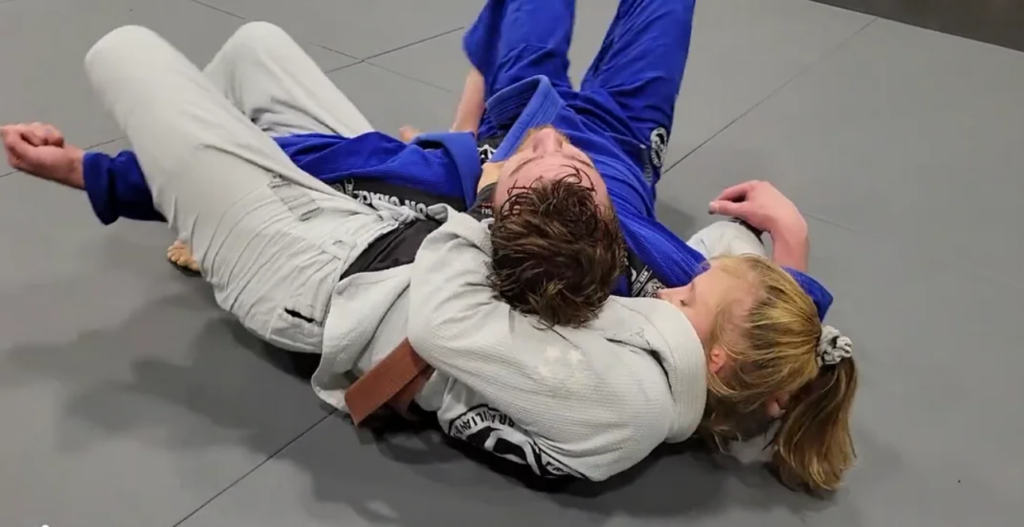


The crucifix position has several different variations that appear throughout grappling martial arts. In Brazilian Jiu-Jitsu, in particular, the crucifix is most often used as a variation of back control, or to improve pinning from the top of side control. In both cases, numerous submission options present themselves, with crucifix chokes being the most reliable one to look into.

What is the Crucifix Position in BJJ?
The crucifix position is very efficient in both grappling and MMA. The question is, why don’t more people use it then, especially in Gi Jiu-Jitsu? Well, for one, it does not earn people points.
Given that most positions that earn points, at least under the IBJJF principles, do so from the perspective of how much control and damage you can apply to an opponent, this seems ridiculous, but let’s not turn this article into an IBJJF witchhunt.
The fact remains that the crucifix position, particularly when done from the back offers extreme amounts of control and very interesting finishing options. The most effective submissions to look for are a bunch of particularly nasty crucifix chokes.
Origins of the Crucifix
The position became popular through the crucifix wrestling move, done by pro wrestler Dan Spivey, and later named the crucifix powerbomb. While it was entertaining to watch, we all know that most pro-wrestling moves are completely unrealistic in a real match/fight. Well, the crucifix is one of those rare exceptions to that rule.
The position most likely originates from Judo, where it is used to break down turtled opponents and immediately choke them. In fact, the crucifix choke utilized by Judokas is named Jigoku-Jime which translates as “hell choke”. That right there is all the validation you need about the crucifix choke.
The way the crucifix is used in modern grappling is mostly from the back, but there’s also a great variation that helps keep people in side control when you are on top. In both cases, chokes are pretty easily available, but what really makes the position a powerful one is the amount of effortless control you have over someone from there.
There is an old wrestling principle called “the pole and the tree”. If you have a tree on the ground, and you have a pole on the ground, which one is going to be easier for you to roll? If your answer is “the pole” you are correct. Obviously, it would be very difficult to roll the tree because of its branches, which is exactly the principle that blocks people from rolling when caught in a crucifix.
Whether it is from the back, or from top side control, the crucifix Jiu-Jitsu position allows you to turn someone into a “tree” by trapping their arms in an “open elbow” position on each side. Combined with the weight of your full body on the shoulder line you have a great position to look for crucifix submissions.
How Do You Put Someone In a Crucifix?
As usual, there are plenty of ways to get to the Crucifix BJJ position, once you know your control checkpoints. For both the back mount and top side control crucifix variations, you entangle one of the opponent’s arms with your legs, and the other with your arms. This gives you lots of power against their weak isolated limbs, which provides the control, and some submission options.
From the back mount, a Kimura grip ensures control over one arm with your arms, at least initially. Controlling the second arm requires a triangle configuration with your legs. That means you’re using two of the most powerful reinforced wedge systems in BJJ to control the limbs of an opponent.
Top side control crucifix has you pinning both arms, this time focusing more on gravity than reinforced wedges. Using your shins to pin the near side arm is not just powerful, but also very painful for the bottom person. There are several ways to control the far side arm using your arms, but the best one is to place an underhook, grabbing the shoulder of the opponent. It is one of the tightest op pins in Jiu-Jitsu.
Crucifix Chokes In No-Gi
Now, let’s talk about how to actually put people to sleep from the crucifix. Of course, you have lots of arm-locking options as well, but there’s nothing quite like making people tap with chokes. After all, they’re the only submission people can’t just power out of and endure for long.
Mounted Triangle Crucifix Finish
Start off by lifting the shoulder on the far side up, along with the head. You can cup the head or get a grip on the back of the collar. This places the bottom person under pressure, similar to S-mount but with extra control via the pinned near side arm.
Put your free leg behind the head of the opponent, bunching them up. From there, you’re in the perfect position to slide that leg under the head, getting your hip to the ground. Sliding the other leg across the opponent’s chest will get you straight into a mounted triangle.
Inverted Triangle
Another useful triangle crucifix choke from top side control is the inverted trinagle. For this version, instead of going under the head with the free leg, you go over it, while releasing the pinned near side arm so that you have a triangle position.
No-Gi Crucifix Rear Naked Choke
A very reliable crucifix choke option from the back crucifix in No-Gi is the good old rear naked choke. After all, the opponent has no arms that can defend, while you have a free arm, positioned perfectly to start attacking the neck.
All you need to do is put in reps on finishing the rear naked choke with one arm, which is actually easy. Just get your palm behind their shoulder and use your fingers to find a “ledge” on their back that you can hold on to.
You can also opt to go around the head (like for a guillotine). Then, use the top leg and place it around the opponent’s torso, so that you and sneak the choking arm underneath it. You are a palm-to-palm grip and a squeeze away from a nasty and unexpected crucifix choke. Check out the video below for details:
Gi Crucifix Chokes
With the Gi your options to both control and finish from the crucifix position increase, just like with any other attack. With more places to get tight grips on, and the lapels serving as extensions of your arms or legs, you can finish even the most stubborn opponents from the BJJ crucifix.
Paper Cutter Choke
One of the easiest Brazilian Jiu-Jitsu chokes to set up from a top side control crucifix is the paper cutter. The original paper cutter choke works by trapping the near side shoulder before choking.
Since both shoulders are trapped and pinned in the crucifix, all you need is to place the free arm across the neck. This crucifix choke requires a grip with your thumb inside the collar. Make sure you touch your elbow to the ground and continue to open up the elbow towards the opponent’s head for a tap.
From the back crucifix, it is choking galore, whether you opt for the collar or your own lapels. Collar chokes are pretty easy – same as if you would set up a rear naked choke, but you need less space since the Gi is easier to grip and provides a tighter choking option.
Lapel Chokes from The Crucifix Jiu-Jitsu Postiion
Lapels are where things get tricky but interesting. Your own lapels are better suited for the job, given their proximity to the neck. However, you can also use their own lapels to further trap their arms, or more precisely, the arm you’re controlling with your own arms.
For a lapel crucifix choke though, all you need is to free up your lapel, regardless of side, and wrap it around the neck of the opponent. From there, you can directly squeeze, or put more pressure on by using your legs. Also worth mentioning is that you can wrap a lapel around the neck from either direction, making it all the more confusing for your opponent.
Escaping the Crucifix
When it comes to beating crucifix chokes, you’re not going to have too much success. However, getting out of the position before the opponent starts setting chokes up is a viable option. In order to achieve that, you need to e aware of the position’s main strengths and beat them early.
Early on, your best bet is to start bridging so that the top of your head reaches the ground over the opponent. The goal will be to free up the arm that is trapped by the legs.
That means the direction of your bridging will be diagonal, over the far shoulder of the opponent. This will help you get your arm out as long as you keep it limp and loose. From there on, it is easy to completely disengage, or go for counterattacks.
One thing you can do later on is try to disentangle the control they have over one arm with their legs. Your goal is to walk your legs towards theirs, curling your body up so you can trap one of their legs with both of yours.
You can use this configuration to sneak your trapped arm out, thus preventing most chokes. In order to completely escape, you’ll also need to free up the other arm, but that’s easier now that you’re no longer crucified.
Using the Crucifix to Submit
Attacking with crucifix submissions is not just limited to crucifix choke BJJ variations. You can freely hunt armlocks as well, with wristlocks and biceps slicers being particularly brutal and effective. Given the success rate of chokes, though, my suggestion is to start with them from the crucifix and then expand your submission game from there. You can always spice it up with an armlock or two.
Darragh O’Conaill Crucifix Encyclopedia DVD Review [2024]
Side Control Crucifix Attacks To Make Yourself Enemies In The Gym
Alexandre Vieira DVD – The Crucifix And Loop Choke














